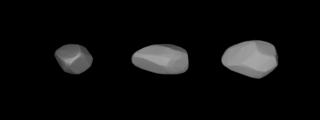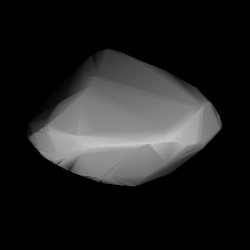Related Research Articles

364 Isara is a stony Florian asteroid from the inner regions of the asteroid belt, approximately 27 kilometers in diameter. It was discovered on 19 March 1893, by French astronomer Auguste Charlois at the Nice Observatory in southeast France. The asteroid was named after the Isère River in France.
1853 McElroy, provisional designation 1957 XE, is an asteroid from the outer region of the asteroid belt, approximately 21 kilometers in diameter. It was discovered on 15 December 1957, by the Indiana Asteroid Program at Goethe Link Observatory near Brooklyn, Indiana, United States, and named for American biochemist William D. McElroy.
2023 Asaph, provisional designation 1952 SA, is a dark asteroid from the outer regions of the asteroid belt, approximately 21 kilometers in diameter. It was discovered on 16 September 1952, by astronomers of the Indiana Asteroid Program at Goethe Link Observatory in Indiana, United States.
1015 Christa, provisional designation 1924 QF, is a dark background asteroid from the outermost regions of the asteroid belt, approximately 96 kilometers in diameter. It was discovered on 31 January 1924, by German astronomer Karl Reinmuth at the Heidelberg-Königstuhl State Observatory in southwest Germany. The meaning of this asteroids's name is unknown.

1042 Amazone, provisional designation 1925 HA, is a dark asteroid and slow rotator in the outer asteroid belt, approximately 70 kilometers in diameter. It was discovered on 22 April 1925, by German astronomer Karl Reinmuth at Heidelberg Observatory in southern Germany. It is named after the Amazons from Greek mythology.
1043 Beate, provisional designation 1925 HB, is a stony asteroid from the outer region of the asteroid belt, approximately 32 kilometers in diameter. It was discovered by German astronomer Karl Reinmuth at the Heidelberg-Königstuhl State Observatory on 22 April 1925. Any reference of its name to a person is unknown.
1115 Sabauda is a carbonaceous Meliboean asteroid from the outer region of the asteroid belt, approximately 68 kilometers in diameter. Discovered in 1928 by Italian astronomer Luigi Volta, it was assigned the provisional designation 1928 XC. The asteroid was probably named after the House of Savoy, the former rulers of Italy.
1477 Bonsdorffia, provisional designation 1938 CC, is a background asteroid from the outer regions of the asteroid belt, approximately 29 kilometers in diameter. It was discovered on 6 February 1938, by astronomer Yrjö Väisälä at the Iso-Heikkilä Observatory in Turku, Finland. The asteroid was named after Finnish astronomer Ilmari Bonsdorff, who founded the Finnish Geodetic Institute.
2892 Filipenko, provisional designation 1983 AX2, is a carbonaceous asteroid from the outer region of the asteroid belt, approximately 60 kilometers in diameter.
17683 Kanagawa (provisional designation 1997 AR16) is a carbonaceous background asteroid from the outer region of the asteroid belt, approximately 22 kilometers (14 miles) in diameter. It was discovered on 10 January 1997, by Japanese astronomer Atsuo Asami at the Hadano Observatory, located 60 kilometers southwest of Tokyo, Japan. The asteroid was later named after the Japanese Kanagawa Prefecture.
1817 Katanga, provisional designation 1939 MB, is a stony Phocaea asteroid in from the inner regions of the asteroid belt, approximately 16 kilometers in diameter. It was discovered on 20 June 1939, by English-born South African astronomer Cyril Jackson at Johannesburg Observatory in South Africa. It is named for the Katanga Province.
1504 Lappeenranta, provisional designation 1939 FM, is a stony background asteroid from the inner regions of the asteroid belt, approximately 12 kilometers in diameter. It was discovered on 23 March 1939, by Finnish astronomer Liisi Oterma at the Iso-Heikkilä Observatory, and named after the city of Lappeenranta in Finland.
1176 Lucidor, provisional designation 1930 VE, is a carbonaceous background asteroid from the central region of the asteroid belt, approximately 30 kilometers in diameter. It was discovered by Eugène Delporte in 1930, who named it after a friend.

1659 Punkaharju, provisional designation 1940 YL, is a stony Postremian asteroid from the middle region of the asteroid belt, approximately 30 kilometers in diameter. It was discovered on 28 December 1940, by Finnish astronomer Yrjö Väisälä at Turku Observatory in Southwest Finland. It is named for the municipality of Punkaharju.
1323 Tugela, provisional designation 1934 LD, is a dark background asteroid from the outer regions of the asteroid belt, approximately 60 kilometers in diameter. It was discovered on 19 May 1934, by South African astronomer Cyril Jackson at the Union Observatory in Johannesburg. The asteroid was named for the Tugela River in western South Africa.

1186 Turnera, provisional designation 1929 PL, is a stony Eoan asteroid from the outer regions of the asteroid belt, approximately 36 kilometers in diameter. It was discovered on 1 August 1929, by South African astronomer Cyril Jackson at the Union Observatory in Johannesburg. The asteroid was later named after British astronomer Herbert Hall Turner.

1940 Whipple is a carbonaceous background asteroid from the outer region of the asteroid belt, approximately 35 kilometers in diameter. It was discovered on 2 February 1975, by the Harvard College Observatory at its George R. Agassiz Station near Harvard, Massachusetts, in the United States, and named after astronomer Fred Whipple.

1336 Zeelandia, provisional designation 1934 RW, is a stony Koronian asteroid from the outer regions of the asteroid belt, approximately 21 kilometers in diameter. It was discovered on 9 September 1934, by Dutch astronomer Hendrik van Gent at the Union Observatory in Johannesburg, South Africa. The asteroid was named for the Dutch province of Zeeland.
1341 Edmée, provisional designation 1935 BA, is a rare-type metallic asteroid from the central region of the asteroid belt, approximately 27 kilometers in diameter.
1461 Jean-Jacques, provisional designation 1937 YL, is a metallic asteroid from the outer region of the asteroid belt, approximately 34 kilometers in diameter. It was discovered on 30 December 1937, by French astronomer Marguerite Laugier at Nice Observatory in southern France, who named it after her son Jean-Jacques Laugier.
References
- 1 2 3 4 5 "JPL Small-Body Database Browser: 1832 Mrkos (1969 PC)" (2017-03-29 last obs.). Jet Propulsion Laboratory . Retrieved 8 June 2017.
- 1 2 3 Schmadel, Lutz D. (2007). "(1832) Mrkos". Dictionary of Minor Planet Names – (1832) Mrkos. Springer Berlin Heidelberg. p. 147. doi:10.1007/978-3-540-29925-7_1833. ISBN 978-3-540-00238-3.
- 1 2 3 4 Usui, Fumihiko; Kuroda, Daisuke; Müller, Thomas G.; Hasegawa, Sunao; Ishiguro, Masateru; Ootsubo, Takafumi; et al. (October 2011). "Asteroid Catalog Using Akari: AKARI/IRC Mid-Infrared Asteroid Survey". Publications of the Astronomical Society of Japan. 63 (5): 1117–1138. Bibcode:2011PASJ...63.1117U. doi:10.1093/pasj/63.5.1117. (online, AcuA catalog p. 153)
- 1 2 3 4 Masiero, Joseph R.; Mainzer, A. K.; Grav, T.; Bauer, J. M.; Cutri, R. M.; Nugent, C.; et al. (November 2012). "Preliminary Analysis of WISE/NEOWISE 3-Band Cryogenic and Post-cryogenic Observations of Main Belt Asteroids". The Astrophysical Journal Letters. 759 (1): 5. arXiv: 1209.5794 . Bibcode:2012ApJ...759L...8M. doi:10.1088/2041-8205/759/1/L8 . Retrieved 15 December 2016.
- 1 2 3 4 5 "LCDB Data for (1832) Mrkos". Asteroid Lightcurve Database (LCDB). Retrieved 15 December 2016.
- 1 2 3 4 Tedesco, E. F.; Noah, P. V.; Noah, M.; Price, S. D. (October 2004). "IRAS Minor Planet Survey V6.0". NASA Planetary Data System – IRAS-A-FPA-3-RDR-IMPS-V6.0. Bibcode:2004PDSS...12.....T . Retrieved 17 October 2019.
- 1 2 Warner, Brian D. (June 2005). "Asteroid lightcurve analysis at the Palmer Divide Observatory - fall 2004". The Minor Planet Bulletin. 32 (2): 29–32. Bibcode:2005MPBu...32...29W. ISSN 1052-8091 . Retrieved 15 December 2016.
- ↑ Veres, Peter; Jedicke, Robert; Fitzsimmons, Alan; Denneau, Larry; Granvik, Mikael; Bolin, Bryce; et al. (November 2015). "Absolute magnitudes and slope parameters for 250,000 asteroids observed by Pan-STARRS PS1 - Preliminary results". Icarus. 261: 34–47. arXiv: 1506.00762 . Bibcode:2015Icar..261...34V. doi:10.1016/j.icarus.2015.08.007 . Retrieved 15 December 2016.
- 1 2 "1832 Mrkos (1969 PC)". Minor Planet Center. Retrieved 15 December 2016.
- ↑ Schmadel, Lutz D. "Appendix – Publication Dates of the MPCs". Dictionary of Minor Planet Names – Addendum to Fifth Edition (2006–2008). Springer Berlin Heidelberg. p. 221. doi:10.1007/978-3-642-01965-4. ISBN 978-3-642-01964-7.